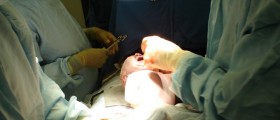Forceps is an instrument used in surgery to grab, maneuver or remove different things from the body. This instrument looks like a pair of tongs and can be used as a way to deliver the baby.
Commonly used instruments are Simpson and Tucker-McLane forceps or the Simpson forceps with the Luikart modification. Which instrument is going to be used in delivery depends on the indications for its use and specific conditions of the delivery.

Before the Procedure
Doctors must confirm the presence of a condition that requires forceps delivery before any procedure takes place. A pregnant woman must give her verbal consent for this forceps delivery. In some situations, this procedure is performed urgently.
Before the forceps delivery, it should be decided which anesthesia will be used. Some doctors recommend the use of only local filtration anesthesia. However, others are strongly convinced that this procedure requires more adequate anesthesia.
Pudendal block anesthesia may be enough for very few pregnant women, while many more find this level of anesthesia intolerable. A combination of intravenous sedation and pudendal block anesthesia may work a bit better for some patients. Regional or general anesthesia works for most patients.
In general, doctors prefer using regional anesthesia for this purpose, while general anesthesia is reserved for more severe or emergency situations. Regional anesthesia is usually delivered via epidural or spinal injection. General anesthesia requires that a surgeon is ready before the patient has been given anesthesia.
Patient should empty her bladder before forceps delivery, regardless of what anesthesia or type of instrument will be used for the procedure.
Possible Problems with Forceps Delivery
Forceps-assisted delivery may cause complications for both mother and unborn child. These might be caused by the skill and judgment of the doctor leading the forceps procedure, but this is something that is usually hard to qualify.
Complications during forceps delivery may also be misinterpreted since they are compared to normal childbirth. Many times, forceps delivery is the way to deliver the baby in complicated pregnancy or because of some abnormal labor.
Mothers may experience lacerations, bleeding, and perineal tears (more or less serious, depending on the use of mediolateral episiotomy and forceps technique). Late complications for mothers delivering the baby this way could include damage of the pelvic support tissue, such as fistulae or defects in rectal sphincter function and fecal and urinary incontinence in some cases.
On the baby, forceps instruments may cause marks and bruising on the face. These are usually minor problems, but they can cause long-term disability. Some babies may experience shoulder dystocia and some brain injuries.
In rare occasions, cerebral palsy and slightly lower IQ may also be possible complications of prolonged and difficult forceps delivery. Neonatal death is one of the severe complications of this procedure.
- Operative vaginal delivery with forceps has its benefits. When applied properly during the second stage of labor arrest, it has the potential to eliminate the need for a cesarean section. Cesarean section is a more invasive procedure with an increased risk of complications, and when compared to operative forceps delivery. Cesarean delivery has correlations with an increased risk of postpartum infection.
- Complications are difficult to ascertain due to the lack of studies with adequate control groups.
- Maternal complications: perineal lacerations, vaginal lacerations, and hematomas, anal sphincter injury, long term complication of pelvic organ prolapse.
- Fetal complications: facial lacerations, facial nerve injury, ocular trauma, skull fracture, intracranial hemorrhage, subgaleal hematoma, hyperbilirubinemia, fetal death.

















Your thoughts on this
Loading...